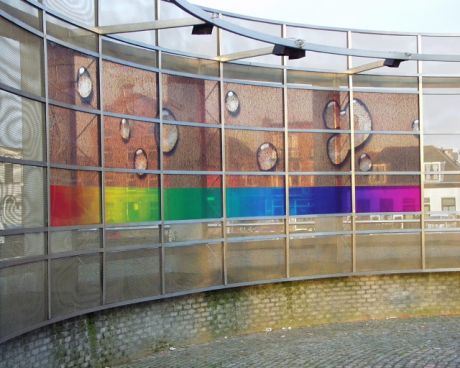Gezicht op Delft
| Kunstenaar: | Thomas Elshuis |
| Straatnaam: | Plein Delftzicht, hoek Hooikade |
| Schieweg | |
| Materiaal: | Aluminium, Kunststof, RVS, Staal, Verlichting |
| Jaar van plaatsing: | 1999 |
...
Omschrijving:
Dit is een magisch punt. Hier schilderde Johannes Vermeer in 1660/1661 zijn wereldberoemde Gezicht op Delft. Het doek zelf hangt in het Mauritshuis in Den Haag. Ondanks allerlei veranderingen in de loop van de decennia kun je hier aan de Hooikade de torens van de Oude en de Nieuwe Kerk nog steeds terugvinden.
Op Vermeers doek staat eigenlijk maar weinig stad. Er is vooral water en lucht te zien met prachtig licht, reflecties en schaduwpartijen. Volgens Thomas Elshuis is Gezicht op Delft dan ook geen stadsgezicht, maar gaat het over licht en water. Elshuis kreeg in het Vermeerjaar van 1996 de opdracht om deze historische locatie met een kunstwerk te markeren.
In de tijd van Vermeer werden er enkele technische ontdekkingen gedaan die met waarneming en licht te maken hadden. Zo toonde de Engelse geleerde Isaac Newton aan dat wit licht bij breking uiteenvalt in alle kleuren van de regenboog (het prisma). Antoni van Leeuwenhoek, stadsgenoot van Vermeer, sleep lenzen en bouwde de eerste krachtige microscoop. Het is niet ondenkbaar dat dergelijke ontdekkingen Vermeer hebben beïnvloed. Hij maakte immers ook gebruik van de camera obscura (Latijn voor donkere kamer).
Dat alles brengt Elshuis samen in zijn Panorama. Opgeleid als architect maakte hij in de jaren negentig met een serie folly’s (bouwsels zonder gebruiksfunctie) de overstap naar de beeldende kunst. Ook toen al had fotografie zijn aandacht. Panorama is een fotografisch werk dat inzoomt op Vermeers wolken en het zand op de oever van de Schie. Waterdruppels vergroten de zandkorrels uit en onderin het beeld prijken de kleuren van het prisma. Elshuis’ folly Panorama creëert een intieme plek en geeft tegelijkertijd een weids zicht: op de stad zelf én op de technische vernieuwingen die vroeger en nu in Delft het licht zien.
Sandra Spijkerman
17 maart 2017
This is a magical point. In the year 1660/1661 Johannes Vermeer painted here his world-famous View of Delft. You can find this painting at the Mauritshuis in The Hague. Despite all changes over the past decades, you can still find the towers of the old and the new Church, here at the Hooikade.
On Vermeer's canvas there is actually very little to see of the city itself. The main focus is the water and air with it’s beautiful light, reflections and shadow. Therefore ‘View of Delft’ isn’t a cityview’ according to Thomas Elshuis, but it is about light and water. During the year of Vermeer in 1996, Elshuis got the job to mark this historic location with a work of art.
Some technical discoveries were made in the time of Vermeer that had to do with perception and light. Such as the discovery of the Prism by English scholar Isaac Newton, which showed that white light in refraction decomposes into all the colours of the Rainbow. Antoni van Leeuwenhoek, fellow townsman of Vermeer, grinded lenses and built the first powerful microscope. Such discoveries must have had influence over Vermeer. Because after all, he also used the camera obscura (Latin for dark room).
Elshuis brings it all together in his Panorama. Trained as an architect, he switched to Fine Arts in the nineties with a series of follies (buildings without any using function). Even then, photography had his attention. Panorama is a photographic work that focuses on Vermeer’s clouds and the sand on the banks of the river Schie. Water droplets increase the grains of sand and at the bottom of the image the colors of the prism are adorned. Elshuis' folly Panorama creates an intimate place and at the same time it gives a panoramic view: on the city itself and on the technical innovations that see the light in Delft in past and present times.
Sandra Spijkerman
March 17, 2017
Beschrijvingen door bewoners:
Plattegrond:





